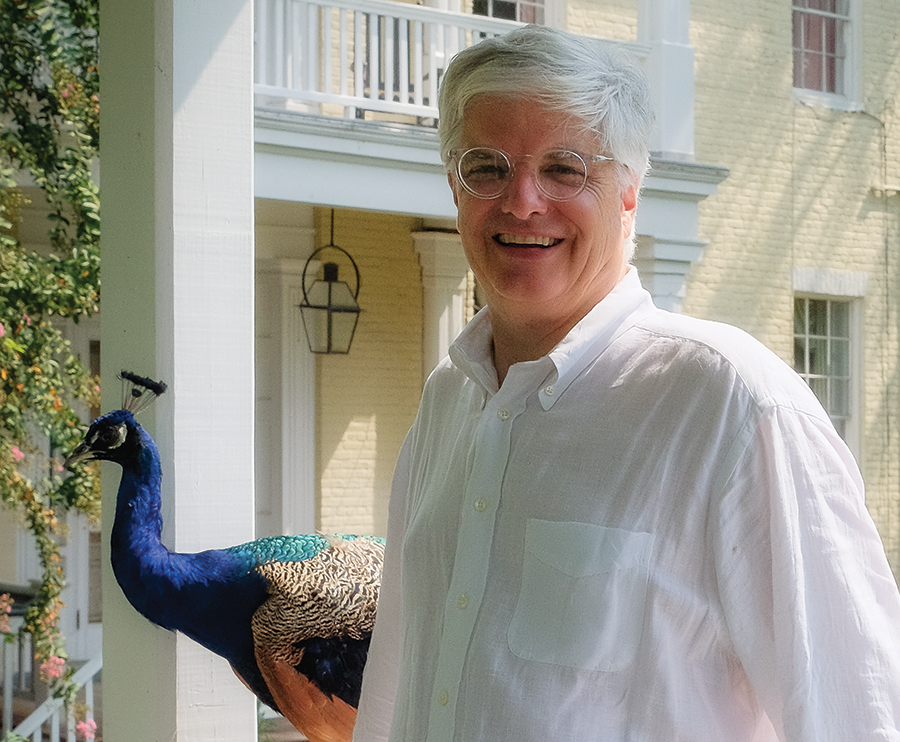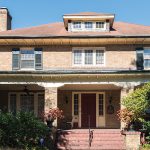In beautiful Edenton, history lives and life moves on Sambo time
By Jim Moriarty • Photographs by Kip Shaw
Sambo Dixon wraps his hands around the full quiver of his historic peacock’s tail feathers and repositions the bird to a lookout perch at the top of the garden cupola next to his Edenton house, Beverly Hall. A place for everything and everything in its place. The bird registers its objection with a guttural squawk about half an octave above Harpo Marx’s horn. This was our starter’s pistol.
Trailing behind Dixon on a speed walking tour of Edenton leaves one feeling a bit like the pig at the end of the Michael J. Fox’s leash on a stroll through Grady in Doc Hollywood. There’s not a soul, from mayor to roofer, banker to gardener, who does not greet Edenton’s best-known lawyer when they see him on the sidewalk with his white hair, matching milky opaque eyeglass frames, sockless loafers and khaki slacks. There’s a certain familiarity in a small town attached to someone whose family, on one side or the other, has lived in the same house since 1820.
Dixon is a country lawyer who does a little bit of everything but concentrates on capital cases. His law office is behind Beverly Hall in a building once occupied by slaves. It was his grandfather, Richard Dillard Dixon’s, law office, too. A superior court judge, the elder Dixon was appointed by President Harry Truman to assist as an alternate judge in the Nuremberg tribunals. He tried four cases, including the so-called Doctors’ trial of 23 Nazis. Chief among them was Hitler’s personal physician, Karl Brandt.
Folks scoop up history in Edenton the way most towns recycle plastic. They did it when the old cotton mill closed, turning it into condos and the blocks of workers’ homes into cozy bungalows. Near the peacock’s cupola — the birds’ lineage, spiritually if not directly, runs back a hundred years itself — is an outbuilding Dixon found in Chapanoke, a tiny Perquimans County town, and moved to Beverly Hall as if it was a rusty old Dodge pickup on blocks. He rescued the 18th century house from demolition. “They were going to burn it,” he says as if the prospect was as distasteful to him as drowning puppies.
Dixon stops in front of Beverly Hall as a car rattles down King Street. “That guy, his name is James Bond,” he says, pointing at the car bouncing toward Broad Street, the town’s central business district. “His father buried guns under a church in Edenton during the Civil War.” A mental calculator does a mathematical whirligig and Dixon adds that Bond’s father had been a boy in the 1860s and that Bond, no youngster himself, was a late-in-life baby. We cross King and walk right into Pembroke Hall, a Greek-Revival home on the National Register of Historic Places built in the early 1800s. It’s OK. Dixon was one of the people who pooled the resources necessary to save it. He runs through the sequence of owners like a menu for Chinese food. Workmen are busy getting it ready for the new owner and pay little attention to Dixon, who wants to show off the unobstructed view from the back porches. “It has protective covenants on it,” he says of the vista of Edenton Bay. “There’ll never be anything built over there.”
We cut through Pembroke Hall’s expansive backyard with its ghosts of grand parties past, skip down a few cement stairs and make for the lighthouse beside the small in-town harbor. The wind is blowing off the bay, and it’s hard to catch every word from two strides behind. “Ten-year preservation project,” he says. Then I hear: “It sat at the mouth of the Roanoke River.” There’s something about 1886, which barely qualifies as old in Edenton. “It’s called a screw pile lighthouse because they screwed these things into the sound floor.” We climb up the twisting staircase to the top and duck through an opening onto a tiny catwalk. A workman follows us. He doesn’t want anyone falling through the hole in the floor. Dixon assures him of our agility. “Here’s my favorite part,” he says. “We’ve got the fresnel lens now. We’ll put that back in, hopefully sooner rather than later.” Dixon points across the bay. “That’s Queen Anne’s Creek and that’s Pembroke Creek. Right across Albemarle Sound is where they think the Lost Colony went. You been following that?” It’s known as Site X, discovered after an X-ray examination of a watercolor map drawn by Gov. John White in 1585 indicated the possibility of the existence of the inland location.

And we’re off again, walking down the salvaged parts of the old Chowan River Bridge, cut into sections and made into a breakwater, creating a small sheltered port for boats traveling up and down the Intracoastal Waterway. Behind the lighthouse is the old Edenton Ice Company building. John Conger Glover, formerly of Harris Wholesale Inc., wants to turn what had been his grandfather’s obsolete business into a modern brewpub. “We have a lot of young families now, which is a rarity in eastern North Carolina,” Dixon says.
He explains how even by the late 1700s, the bay was already too shallow to accommodate the larger ships. A hurricane in 1795 would close the ocean inlet completely and Edenton would stay forever small. “My crowd,” is the way Dixon singles out his ancestors. One of them, William Badham Jr., another lawyer, formed the Edenton Bell Battery. “They melted down the church bells and made them into cannons. Captured at the Battle of Town Creek. (One of them, anyway.) They weren’t found for another 125 years. You don’t see many bronze cannons,” he says.
The six-pounder is named Edenton, the 12-pounder St. Paul. The first was found on display at the Shiloh National Military Park and the second at Old Fort Niagara. They’re positioned outside the Barker House, the town’s visitor’s center. Dixon climbs the stairs. “Hey, how you doin’?” he says to a stranger coming out, the first person he’s seen that he doesn’t know. “First political activity by women in America,” he says of the Edenton Tea Party of 1774. “This was the lady. This was her house.” Like the lighthouse, Penelope Barker’s home was moved from its original location two blocks north to the spiffy spot on the water it occupies now. Outside there are more cannon. “These were brought over by a Frenchman on something called the Holy Heart of Jesus (Coeur de Saint Jésus) and nobody would pay for them so he got mad and sunk the ship. At some point they went out and pulled them up. They tried to shoot them during the Civil War when the Northern troops were coming in, and they said it was more dangerous to stand behind them than to stand in front of them.” He points to the scraggly cluster of cypress in the water a few yards away. “That’s the dram tree. Ships coming in would bring West Indian rum and put it in a little bottle and ships going out would make a toast,” he says.
We head toward the Colonial green by way of the path along the water. Two men are fishing. From a distance it looks like all they’ve caught are a couple of missionaries in white shirts and dark ties. Dixon even loves the water in Edenton. “It’s fresh water, too,” he says. “No barnacles. No sharks. No jellyfish.” He asks the men with the poles if they’ve caught anything.
“A mess of white perch,” one replies.
“Good enough to eat?”
“Oh, yeah.”
We cross the street and Dixon knocks on the side door of the house called Homestead. Frances Inglis tells us to come in. While her voice has the quaver of time and her frame is slight, she still has the stamina to command a division of volunteers in straw hats and gardening gloves armed with hand trowels to maintain the grounds at the Cupola House. Inglis played a central role in saving the Jacobean-design house, a National Historic Landmark built in 1758 and the first community-inspired historic preservation in the state of North Carolina. We take a quick tour of Homestead and its double porches. “See through and breeze through,” she says. On a table sits a signed letter from Orville Wright, framed along with a piece of fabric. The note, with handwritten corrections, reads:
As a token of my appreciation of your courtesy in surrendering a piece which you had of our 1905 plane, I present to you two pieces of the “Kitty Hawk” which flew at Kill Devil Hills on December 17, 1903.
I authenticate the above pieces as genuine parts of the original “Kitty Hawk,” plane. They are from parts broken when the plane, while standing on the ground, was overturned by the wind after the fourth flight of the day.
Inglis explains her family had a beach house at Nags Head. “My father had a little canvas canoe. He used to paddle up from the cottage to the sight of the Wright brothers. They had abandoned the place. He gathered up this thing that was a wing tip of the 1902 glider. He had parts of the 1905 plane, the first one to fly two people.”
Next to the Wright brothers table is a wooden chest. On top of the chest is a woven basket of African design, made in the 1850s. The small trunk underneath is the camp chest of Tristrim Lowther Skinner — one of Inglis’ crowd. Inside are his sash, insignia, epaulets and a belt drawn in because he was losing weight. He was killed in 1862 and when she’s asked where, Inglis replies, “Mechanicsville,” in a voice so soft it’s as if the news just arrived. “Trim, they called him,” she says. The Skinner family papers, including letters home from the battlefield, are in the Southern Historical Collection at UNC-Chapel Hill.
Outside Homestead, we race past a large monument. “This is the Joseph Hewes Memorial. He was great friends with John Paul Jones. That’s about him,” Dixon says with a sweep of his hand. At the other end of the green we hop up the steps and enter the front door of the Chowan County Courthouse, a National Historic Landmark built in 1767, and the oldest active courthouse in North Carolina. The state Supreme Court still convenes there for ceremonial occasions. “They sit up there on those hard, terrible benches, but they love coming here,” Dixon says. Inside, there’s a welcoming committee of two, Judy Chilcoat and Carolyn Owens. One of the ladies taught Sambo Dixon math. He apologizes for that less than stellar bit of history. We go upstairs to the central window facing the green below. “When they ratified the Constitution and the Declaration of Independence and the Articles of Secession, they read them out of this window to the people down below. We had a signer of the Declaration of Independence, a signer of the Constitution and a person on the first Supreme Court from here,” says Dixon.
Behind the courthouse we pass the empty jail building, oldest in the state. Dixon wonders out loud what it might be repurposed for. Perhaps something servicing the nearby 60-room boutique hotel planned for the old Hotel Hinton, a 20th century testimonial to utilitarian architecture already upgraded once into county government offices and then downgraded into deserted. We skip onto Broad Street, a small commercial district so 1950s if you didn’t see Michael J. Fox with his pig, you might see him screeching by in his DeLorean. Dixon points out the bank. “The story I’ve always heard,” he says, “is that during the Depression, there was going to be a run on the bank, so a bunch of local folks went to the mint and got a bunch of one dollar bills and put hundred dollar bills on top and said the bank was safe and it wasn’t.”
Next is St. Paul’s Episcopal Church, organized in the Vestry Act of 1701. “That’s all my crowd,” Dixon says with a gesture so expansive it’s as if the gravestones were acres of corn with too many ears to pick just one. “I’ve got the pew rent books at home from the 1840s. I’ve got 10 or 11 generations buried in this church.” We walk inside and he looks around at the altar and the balconies. “Every part of my life would begin and end here,” he says.
Someone is trimming hedges as we leave. There are vines intertwined with the shrubs, and Dixon offers advice. “Pull them out like this,” he says. “Don’t break them. Put newspaper around them and spray them with Roundup. It goes back to the root and kills them.” Perhaps the only endangered roots in Chowan County.
“These are 1900s houses. That’s the Conger House. It’s got a ballroom,” Dixon says as we march down Church Street. We walk up to the back door of a small house. It belongs to Daryl Adachi, who moved to Edenton after getting chased out of his renovated Vermont schoolhouse by cold winters a decade or so ago. He head-hunts for financial services companies from his computer.
“This is my where-in-the-world-have-you-been room,” says Adachi. “I’ve got France and Italy and England and Mexico and China.” There is a dead icons room with black and white photography of the Kennedys, Elvis, Dr. King and Marilyn. In another room there’s a wall for his alma mater, Notre Dame. And an Asian room. “I lived in Hong Kong and Japan for a while,” he says. “I subscribe to the Sambo Dixon theory of interior decoration — fill every piece of wall, fill every single table. Make sure there is no space that’s left untouched.”
Robert Beasley is back in town, too. He bought the Granville Queen Inn in June of last year and if it’s possible to give the impression of profound gentleness in a single meeting, Beasley is your guy. Born in Edenton, he grew up in nearby Tyner, attended North Carolina A&T and had a career in business services in the D.C. area. “My grandmother, Vashti Twine, worked for one of the wealthiest ladies in Chowan County, Eliza Elliott. I would go with her some days in the summer when she went to the house to pick the vegetables or dust the house because the lady was always traveling. She had this mansion and all these beautiful things. It did something to me, going with her and having an appreciation for the finer things.” The appreciation found expression in the Granville.
On our way back to Beverly Hall, we cut through the engineering marvel of Wessington, the 1850s Georgian mansion next door. Purchased by Richard Douglas, from Charlottesville, Virginia, it has a geothermal power plant that looks like the guts of a nuclear submarine, or what one imagines the guts of a nuclear submarine might look like.
We come full circle in Dixon’s living room. “The house was built as State Bank of North Carolina in 1810,” he says. “They have all this early interior security. There are iron bars that go across the windows at night. Here’s the vault. The two burn marks? The way it stopped being a bank was the teller embezzled all the money, put the books on the floor, set them on fire. There was a run on the bank. He ran out in the back yard and shot himself, but people were so angry they took him down to the courthouse and tried him after he was dead and hung him on the green.”
Dixon points out the Civil War camp chest belonging to William Badham — his crowd. There’s a set of dueling pistols and a silver service. A book by James Iredell, Edenton’s member of the first Supremes, is in a library full of books with old notes and pressed flowers inside. “You never know what you’re gong to find in them,” he says.
Dixon looks at his watch. “I got to go see a guy in jail about a murder.”
Photos of Edenton by Kip Shaw accompanying this article can be found in Hospitality, Edenton Style to be published in November by Pembroke Bay Press, 2333 Locust Grove Road, Edenton, NC 27932.


